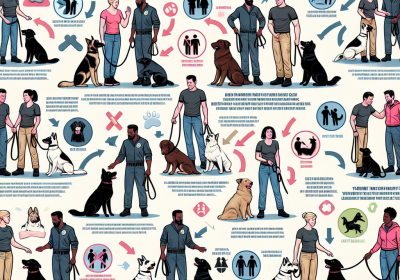Force-Free Training Techniques for Stubborn or Reactive Dogs
Table of Contents
Force-free training techniques for stubborn or reactive dogs focus on using positive reinforcement and non-coercive methods to encourage desirable behaviors and manage challenging ones. These techniques emphasize understanding the underlying causes of a dog’s reactivity or stubbornness, such as fear, anxiety, or lack of proper socialization, and addressing them through patience and empathy. By rewarding positive behaviors with treats, praise, or play, and avoiding punishment or aversive methods, force-free training fosters a trusting relationship between the dog and owner. This approach not only helps in modifying the dog’s behavior but also enhances their overall well-being, making it a humane and effective strategy for training dogs with challenging temperaments.
Understanding the Science Behind Force-Free Training for Reactive Dogs
Force-free training techniques have gained significant attention in recent years, particularly for their effectiveness in managing stubborn or reactive dogs. Understanding the science behind these methods is crucial for pet owners and trainers who aim to foster a harmonious relationship with their canine companions. At the core of force-free training is the principle of positive reinforcement, which involves rewarding desired behaviors to encourage their recurrence. This approach contrasts sharply with traditional training methods that often rely on punishment or aversive stimuli to suppress unwanted behaviors. By focusing on positive reinforcement, force-free training not only enhances the dog’s learning experience but also strengthens the bond between the dog and its handler.
The science behind force-free training is rooted in behavioral psychology, particularly the work of B.F. Skinner, who demonstrated that behaviors followed by positive outcomes are more likely to be repeated. This principle, known as operant conditioning, is fundamental to force-free training. When a dog exhibits a desired behavior, such as sitting on command or walking calmly on a leash, it is immediately rewarded with treats, praise, or play. This positive outcome reinforces the behavior, making it more likely to occur in the future. Over time, the dog learns to associate the behavior with positive consequences, leading to a more willing and cooperative attitude.
For reactive dogs, which may exhibit behaviors such as barking, lunging, or aggression in response to certain stimuli, force-free training offers a compassionate and effective solution. Reactive behaviors often stem from fear, anxiety, or frustration, and using force or punishment can exacerbate these emotions, leading to an escalation of the problem. Instead, force-free training focuses on changing the dog’s emotional response to the trigger. This is achieved through a process known as desensitization and counter-conditioning. Desensitization involves gradually exposing the dog to the trigger at a level that does not provoke a strong reaction, while counter-conditioning pairs the presence of the trigger with positive experiences, such as treats or play. Over time, the dog learns to associate the previously distressing stimulus with positive outcomes, reducing its reactivity.
Moreover, force-free training emphasizes the importance of understanding canine body language and communication. By observing subtle cues such as ear position, tail movement, and facial expressions, trainers can gain insight into the dog’s emotional state and adjust their approach accordingly. This awareness allows for a more tailored training experience that respects the dog’s comfort levels and fosters trust.
In addition to its scientific basis, force-free training is supported by ethical considerations. It aligns with the growing recognition of animals as sentient beings deserving of humane treatment. By prioritizing the dog’s well-being and emotional health, force-free training promotes a more ethical approach to behavior modification.
In conclusion, force-free training techniques offer a scientifically sound and ethically responsible method for managing stubborn or reactive dogs. By leveraging the principles of positive reinforcement, desensitization, and counter-conditioning, these techniques not only address behavioral issues but also enhance the overall relationship between dogs and their handlers. As more pet owners and trainers embrace this approach, the potential for creating a more compassionate and understanding environment for our canine companions continues to grow.
Step-by-Step Guide to Implementing Force-Free Techniques with Stubborn Dogs

Implementing force-free training techniques with stubborn or reactive dogs requires patience, consistency, and a deep understanding of canine behavior. These methods focus on positive reinforcement, which encourages desired behaviors through rewards rather than punishment. By fostering a trusting relationship between the dog and the owner, force-free training can effectively address behavioral challenges without causing stress or fear.
To begin with, it is essential to establish a calm and controlled environment. This setting allows the dog to focus on the training without external distractions. Start by identifying what motivates your dog, whether it be treats, toys, or praise. This motivator will serve as a reward for positive behavior, reinforcing the actions you wish to encourage. It is crucial to ensure that the rewards are given immediately after the desired behavior to create a clear association in the dog’s mind.
Next, consistency is key in force-free training. Dogs thrive on routine and predictability, so it is important to maintain a regular training schedule. Short, frequent sessions are more effective than long, sporadic ones, as they keep the dog engaged and prevent frustration. During these sessions, use clear and simple commands, ensuring that your tone of voice remains calm and encouraging. This approach helps the dog understand what is expected and reduces the likelihood of confusion.
In addition to consistency, patience plays a vital role in training stubborn or reactive dogs. Progress may be slow, and setbacks are common, but it is important to remain patient and persistent. If a particular technique is not yielding results, consider adjusting your approach or seeking guidance from a professional dog trainer who specializes in force-free methods. Remember that each dog is unique, and what works for one may not work for another.
Furthermore, understanding the root cause of a dog’s stubbornness or reactivity can significantly enhance the effectiveness of force-free training. Often, these behaviors stem from fear, anxiety, or a lack of socialization. By identifying and addressing these underlying issues, you can tailor your training approach to better suit your dog’s needs. For instance, if a dog is reactive due to fear of other dogs, gradual desensitization and counter-conditioning can help them feel more comfortable in social situations.
As you progress with training, it is important to monitor your dog’s body language and emotional state. Signs of stress, such as panting, yawning, or avoiding eye contact, indicate that the dog may be overwhelmed. In such cases, it is advisable to take a step back and reassess the training plan. Providing breaks and ensuring that the training remains a positive experience will help maintain the dog’s enthusiasm and willingness to learn.
Finally, celebrate small victories along the way. Each step forward, no matter how minor, is a testament to the bond you are building with your dog. By focusing on positive reinforcement and maintaining a supportive environment, you can successfully implement force-free training techniques with even the most stubborn or reactive dogs. This approach not only improves behavior but also strengthens the relationship between you and your canine companion, fostering a harmonious and fulfilling partnership.
Common Mistakes to Avoid in Force-Free Training for Reactive and Stubborn Dogs
Force-free training techniques have gained popularity among dog owners and trainers for their humane and effective approach to modifying canine behavior. However, when dealing with stubborn or reactive dogs, it is crucial to avoid certain common mistakes that can undermine the success of these methods. Understanding these pitfalls can help ensure a more harmonious relationship between the dog and its owner, ultimately leading to a more successful training outcome.
One of the most frequent mistakes in force-free training is the lack of consistency. Consistency is key in any training regimen, but it becomes even more critical when working with stubborn or reactive dogs. These dogs often require clear and predictable cues to understand what is expected of them. Inconsistent commands or rewards can confuse the dog, leading to frustration and a lack of progress. Therefore, it is essential for all family members and anyone involved in the training process to use the same commands and reward systems consistently.
Another common error is the misinterpretation of a dog’s body language. Reactive dogs, in particular, may exhibit behaviors that are easily misunderstood. For instance, a dog that growls or barks may not necessarily be aggressive; it could be expressing fear or anxiety. Misreading these signals can lead to inappropriate responses from the owner, such as punishment or negative reinforcement, which are contrary to force-free principles. Instead, it is important to observe and understand the subtle cues that indicate a dog’s emotional state, allowing for a more empathetic and effective training approach.
Moreover, impatience is a significant barrier to successful force-free training. Owners often expect quick results, especially when dealing with stubborn or reactive dogs. However, these dogs may require more time to learn and adapt to new behaviors. Rushing the process can lead to setbacks and increased stress for both the dog and the owner. It is vital to set realistic expectations and celebrate small victories along the way, reinforcing positive behavior gradually and patiently.
In addition to impatience, another mistake is the overuse of treats as rewards. While treats can be an effective motivator, relying too heavily on them can lead to dependency, where the dog only responds when a treat is present. This can be particularly problematic with stubborn dogs that may choose to ignore commands if they do not see an immediate reward. To avoid this, it is beneficial to incorporate a variety of rewards, such as verbal praise, petting, or playtime, to maintain the dog’s interest and motivation.
Furthermore, neglecting the importance of socialization can hinder the progress of force-free training. Reactive dogs, in particular, may struggle with new environments or unfamiliar dogs and people. Gradual and controlled exposure to different situations can help reduce reactivity and build confidence. However, it is crucial to ensure that these experiences are positive and not overwhelming, as negative encounters can reinforce fear-based behaviors.
Lastly, failing to address the root cause of a dog’s reactivity or stubbornness can impede training efforts. Often, these behaviors are symptoms of underlying issues such as fear, anxiety, or lack of mental stimulation. Identifying and addressing these root causes through environmental enrichment, mental exercises, or professional guidance can significantly enhance the effectiveness of force-free training.
In conclusion, while force-free training techniques offer a compassionate and effective approach to managing stubborn or reactive dogs, avoiding common mistakes is essential for success. By maintaining consistency, understanding canine body language, practicing patience, diversifying rewards, prioritizing socialization, and addressing underlying issues, dog owners can foster a positive and productive training experience.





![The Dog Podcast Uncovers Startling Truths About What We Feed Our Dogs [Press Release]](https://knowledgenook.com.au/wp-content/uploads/2024/08/dog-with-nutritious-food-400x280.jpg)



